HIV: Epidemiology, Pathogenesis, and Global Impact
VerifiedAdded on 2022/09/18
|5
|1304
|21
Report
AI Summary
This report provides a comprehensive overview of Human Immunodeficiency Virus (HIV), examining its epidemiology, pathogenesis, and global impact. It begins by highlighting HIV's status as a global health burden, emphasizing its communicable nature and modes of transmission. The report details prevalence rates, mortality figures, and the impact of HIV in countries like Australia and Malaysia, including historical data and control measures. It delves into the molecular epidemiology of HIV-1, discussing the evolution of the virus, recombination, and super-infection. Furthermore, the report explores the pathogenesis of HIV, including virus transport, immune system responses, and the mechanisms of infection. It also covers the natural history of HIV/AIDS, tracing its origins and spread, and examines the virus's impact on the immune system, including the loss of CD4+ T lymphocytes and other abnormalities. The report concludes by providing references to support the information presented.
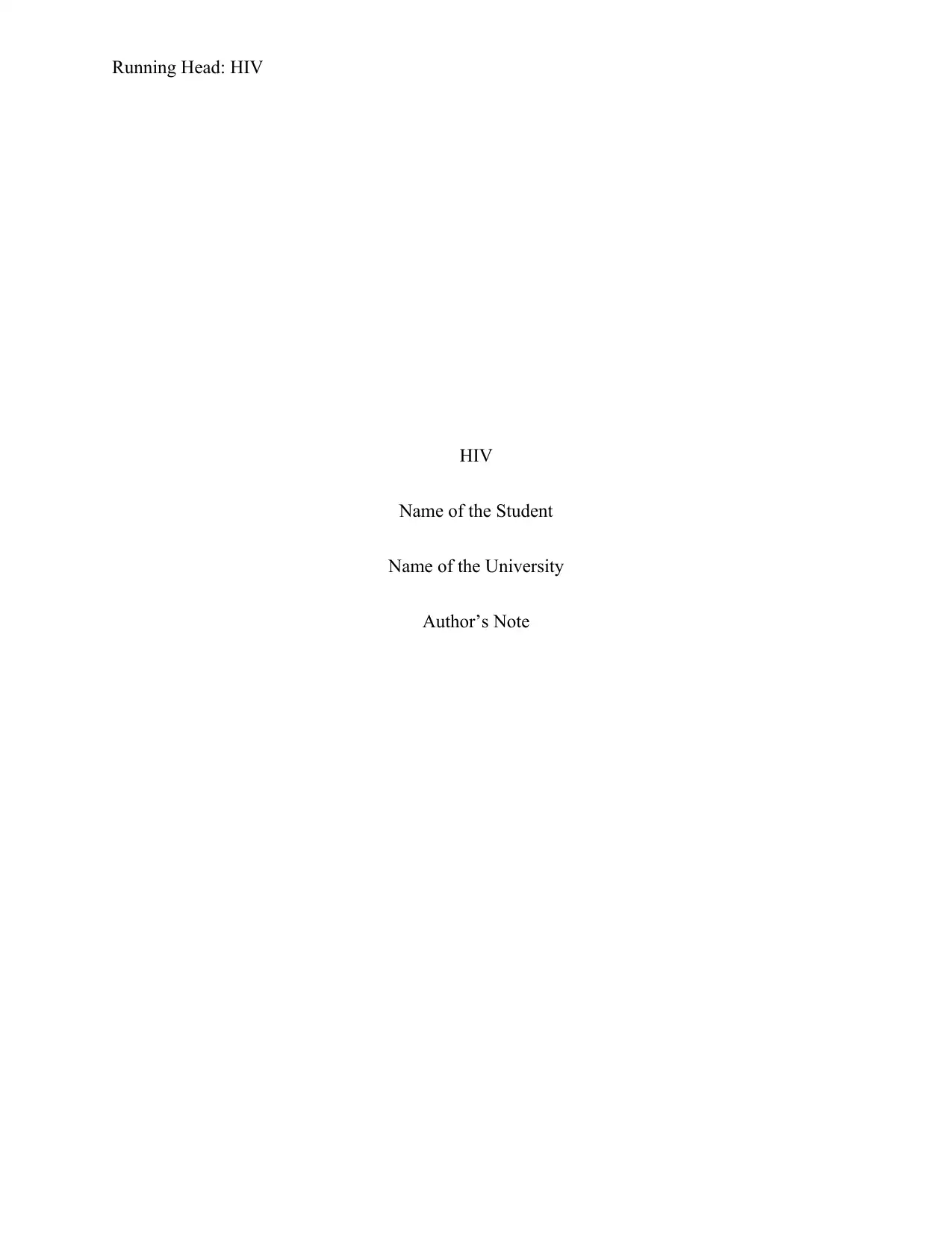
Running Head: HIV
HIV
Name of the Student
Name of the University
Author’s Note
HIV
Name of the Student
Name of the University
Author’s Note
Paraphrase This Document
Need a fresh take? Get an instant paraphrase of this document with our AI Paraphraser
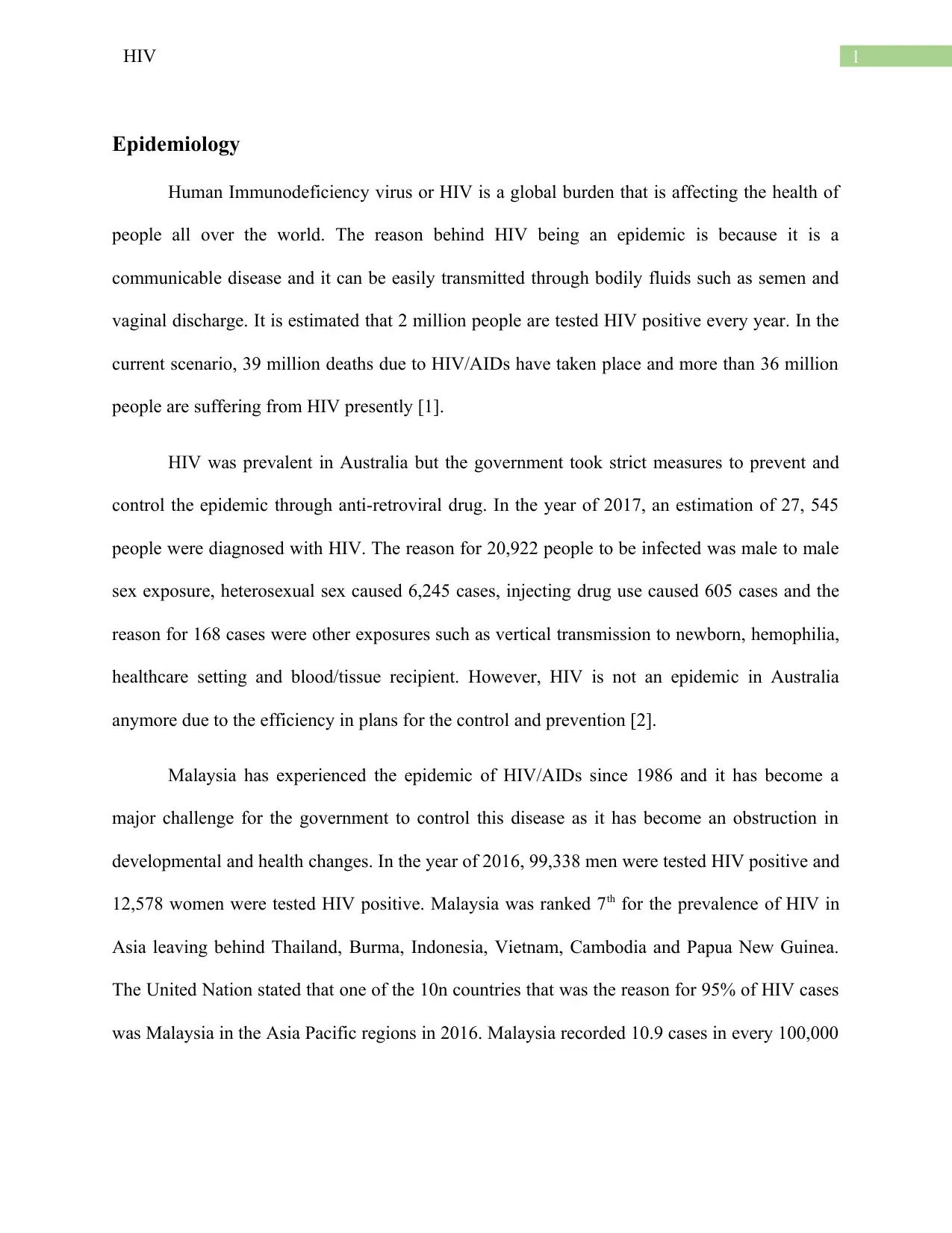
1HIV
Epidemiology
Human Immunodeficiency virus or HIV is a global burden that is affecting the health of
people all over the world. The reason behind HIV being an epidemic is because it is a
communicable disease and it can be easily transmitted through bodily fluids such as semen and
vaginal discharge. It is estimated that 2 million people are tested HIV positive every year. In the
current scenario, 39 million deaths due to HIV/AIDs have taken place and more than 36 million
people are suffering from HIV presently [1].
HIV was prevalent in Australia but the government took strict measures to prevent and
control the epidemic through anti-retroviral drug. In the year of 2017, an estimation of 27, 545
people were diagnosed with HIV. The reason for 20,922 people to be infected was male to male
sex exposure, heterosexual sex caused 6,245 cases, injecting drug use caused 605 cases and the
reason for 168 cases were other exposures such as vertical transmission to newborn, hemophilia,
healthcare setting and blood/tissue recipient. However, HIV is not an epidemic in Australia
anymore due to the efficiency in plans for the control and prevention [2].
Malaysia has experienced the epidemic of HIV/AIDs since 1986 and it has become a
major challenge for the government to control this disease as it has become an obstruction in
developmental and health changes. In the year of 2016, 99,338 men were tested HIV positive and
12,578 women were tested HIV positive. Malaysia was ranked 7th for the prevalence of HIV in
Asia leaving behind Thailand, Burma, Indonesia, Vietnam, Cambodia and Papua New Guinea.
The United Nation stated that one of the 10n countries that was the reason for 95% of HIV cases
was Malaysia in the Asia Pacific regions in 2016. Malaysia recorded 10.9 cases in every 100,000
Epidemiology
Human Immunodeficiency virus or HIV is a global burden that is affecting the health of
people all over the world. The reason behind HIV being an epidemic is because it is a
communicable disease and it can be easily transmitted through bodily fluids such as semen and
vaginal discharge. It is estimated that 2 million people are tested HIV positive every year. In the
current scenario, 39 million deaths due to HIV/AIDs have taken place and more than 36 million
people are suffering from HIV presently [1].
HIV was prevalent in Australia but the government took strict measures to prevent and
control the epidemic through anti-retroviral drug. In the year of 2017, an estimation of 27, 545
people were diagnosed with HIV. The reason for 20,922 people to be infected was male to male
sex exposure, heterosexual sex caused 6,245 cases, injecting drug use caused 605 cases and the
reason for 168 cases were other exposures such as vertical transmission to newborn, hemophilia,
healthcare setting and blood/tissue recipient. However, HIV is not an epidemic in Australia
anymore due to the efficiency in plans for the control and prevention [2].
Malaysia has experienced the epidemic of HIV/AIDs since 1986 and it has become a
major challenge for the government to control this disease as it has become an obstruction in
developmental and health changes. In the year of 2016, 99,338 men were tested HIV positive and
12,578 women were tested HIV positive. Malaysia was ranked 7th for the prevalence of HIV in
Asia leaving behind Thailand, Burma, Indonesia, Vietnam, Cambodia and Papua New Guinea.
The United Nation stated that one of the 10n countries that was the reason for 95% of HIV cases
was Malaysia in the Asia Pacific regions in 2016. Malaysia recorded 10.9 cases in every 100,000
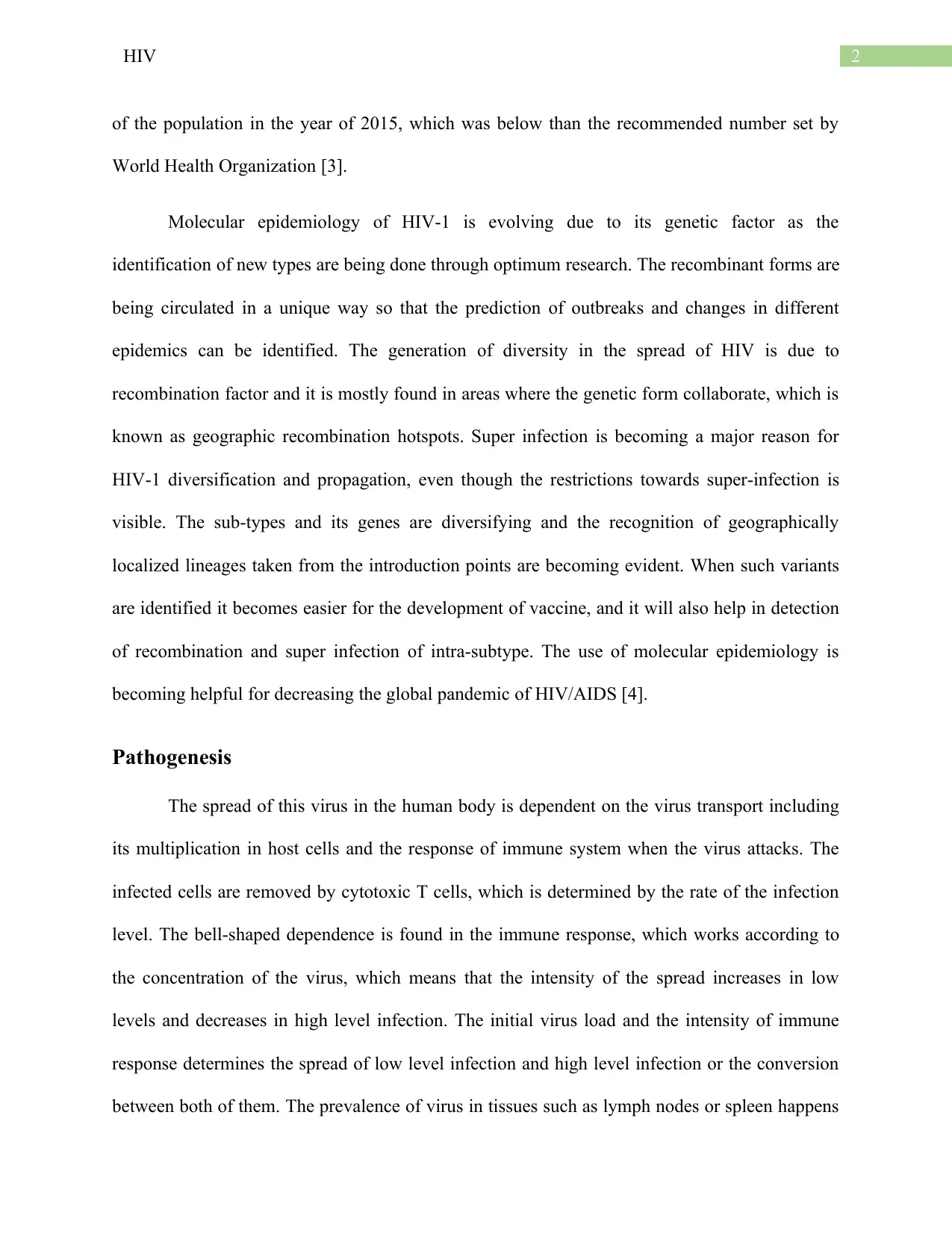
2HIV
of the population in the year of 2015, which was below than the recommended number set by
World Health Organization [3].
Molecular epidemiology of HIV-1 is evolving due to its genetic factor as the
identification of new types are being done through optimum research. The recombinant forms are
being circulated in a unique way so that the prediction of outbreaks and changes in different
epidemics can be identified. The generation of diversity in the spread of HIV is due to
recombination factor and it is mostly found in areas where the genetic form collaborate, which is
known as geographic recombination hotspots. Super infection is becoming a major reason for
HIV-1 diversification and propagation, even though the restrictions towards super-infection is
visible. The sub-types and its genes are diversifying and the recognition of geographically
localized lineages taken from the introduction points are becoming evident. When such variants
are identified it becomes easier for the development of vaccine, and it will also help in detection
of recombination and super infection of intra-subtype. The use of molecular epidemiology is
becoming helpful for decreasing the global pandemic of HIV/AIDS [4].
Pathogenesis
The spread of this virus in the human body is dependent on the virus transport including
its multiplication in host cells and the response of immune system when the virus attacks. The
infected cells are removed by cytotoxic T cells, which is determined by the rate of the infection
level. The bell-shaped dependence is found in the immune response, which works according to
the concentration of the virus, which means that the intensity of the spread increases in low
levels and decreases in high level infection. The initial virus load and the intensity of immune
response determines the spread of low level infection and high level infection or the conversion
between both of them. The prevalence of virus in tissues such as lymph nodes or spleen happens
of the population in the year of 2015, which was below than the recommended number set by
World Health Organization [3].
Molecular epidemiology of HIV-1 is evolving due to its genetic factor as the
identification of new types are being done through optimum research. The recombinant forms are
being circulated in a unique way so that the prediction of outbreaks and changes in different
epidemics can be identified. The generation of diversity in the spread of HIV is due to
recombination factor and it is mostly found in areas where the genetic form collaborate, which is
known as geographic recombination hotspots. Super infection is becoming a major reason for
HIV-1 diversification and propagation, even though the restrictions towards super-infection is
visible. The sub-types and its genes are diversifying and the recognition of geographically
localized lineages taken from the introduction points are becoming evident. When such variants
are identified it becomes easier for the development of vaccine, and it will also help in detection
of recombination and super infection of intra-subtype. The use of molecular epidemiology is
becoming helpful for decreasing the global pandemic of HIV/AIDS [4].
Pathogenesis
The spread of this virus in the human body is dependent on the virus transport including
its multiplication in host cells and the response of immune system when the virus attacks. The
infected cells are removed by cytotoxic T cells, which is determined by the rate of the infection
level. The bell-shaped dependence is found in the immune response, which works according to
the concentration of the virus, which means that the intensity of the spread increases in low
levels and decreases in high level infection. The initial virus load and the intensity of immune
response determines the spread of low level infection and high level infection or the conversion
between both of them. The prevalence of virus in tissues such as lymph nodes or spleen happens
⊘ This is a preview!⊘
Do you want full access?
Subscribe today to unlock all pages.

Trusted by 1+ million students worldwide
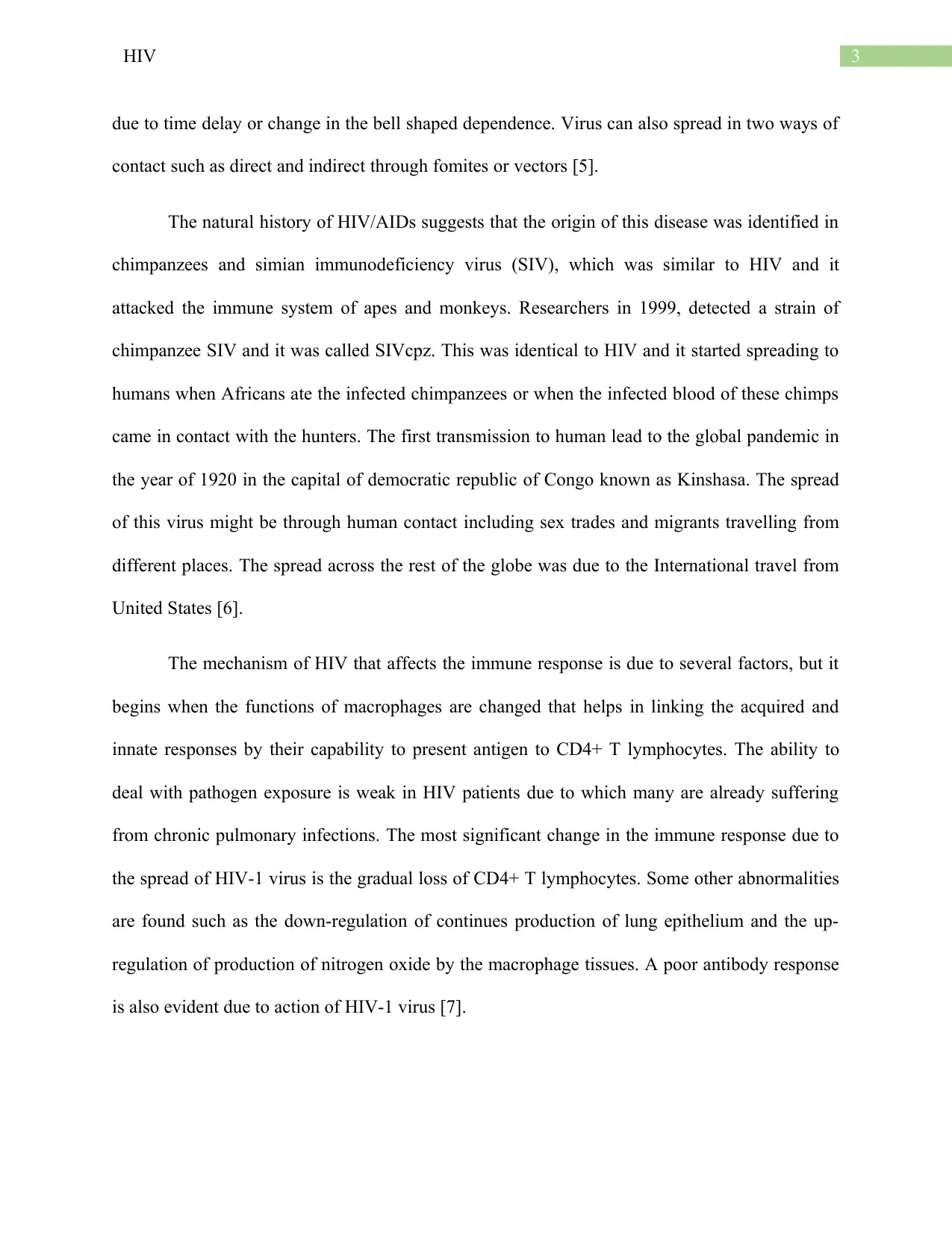
3HIV
due to time delay or change in the bell shaped dependence. Virus can also spread in two ways of
contact such as direct and indirect through fomites or vectors [5].
The natural history of HIV/AIDs suggests that the origin of this disease was identified in
chimpanzees and simian immunodeficiency virus (SIV), which was similar to HIV and it
attacked the immune system of apes and monkeys. Researchers in 1999, detected a strain of
chimpanzee SIV and it was called SIVcpz. This was identical to HIV and it started spreading to
humans when Africans ate the infected chimpanzees or when the infected blood of these chimps
came in contact with the hunters. The first transmission to human lead to the global pandemic in
the year of 1920 in the capital of democratic republic of Congo known as Kinshasa. The spread
of this virus might be through human contact including sex trades and migrants travelling from
different places. The spread across the rest of the globe was due to the International travel from
United States [6].
The mechanism of HIV that affects the immune response is due to several factors, but it
begins when the functions of macrophages are changed that helps in linking the acquired and
innate responses by their capability to present antigen to CD4+ T lymphocytes. The ability to
deal with pathogen exposure is weak in HIV patients due to which many are already suffering
from chronic pulmonary infections. The most significant change in the immune response due to
the spread of HIV-1 virus is the gradual loss of CD4+ T lymphocytes. Some other abnormalities
are found such as the down-regulation of continues production of lung epithelium and the up-
regulation of production of nitrogen oxide by the macrophage tissues. A poor antibody response
is also evident due to action of HIV-1 virus [7].
due to time delay or change in the bell shaped dependence. Virus can also spread in two ways of
contact such as direct and indirect through fomites or vectors [5].
The natural history of HIV/AIDs suggests that the origin of this disease was identified in
chimpanzees and simian immunodeficiency virus (SIV), which was similar to HIV and it
attacked the immune system of apes and monkeys. Researchers in 1999, detected a strain of
chimpanzee SIV and it was called SIVcpz. This was identical to HIV and it started spreading to
humans when Africans ate the infected chimpanzees or when the infected blood of these chimps
came in contact with the hunters. The first transmission to human lead to the global pandemic in
the year of 1920 in the capital of democratic republic of Congo known as Kinshasa. The spread
of this virus might be through human contact including sex trades and migrants travelling from
different places. The spread across the rest of the globe was due to the International travel from
United States [6].
The mechanism of HIV that affects the immune response is due to several factors, but it
begins when the functions of macrophages are changed that helps in linking the acquired and
innate responses by their capability to present antigen to CD4+ T lymphocytes. The ability to
deal with pathogen exposure is weak in HIV patients due to which many are already suffering
from chronic pulmonary infections. The most significant change in the immune response due to
the spread of HIV-1 virus is the gradual loss of CD4+ T lymphocytes. Some other abnormalities
are found such as the down-regulation of continues production of lung epithelium and the up-
regulation of production of nitrogen oxide by the macrophage tissues. A poor antibody response
is also evident due to action of HIV-1 virus [7].
Paraphrase This Document
Need a fresh take? Get an instant paraphrase of this document with our AI Paraphraser
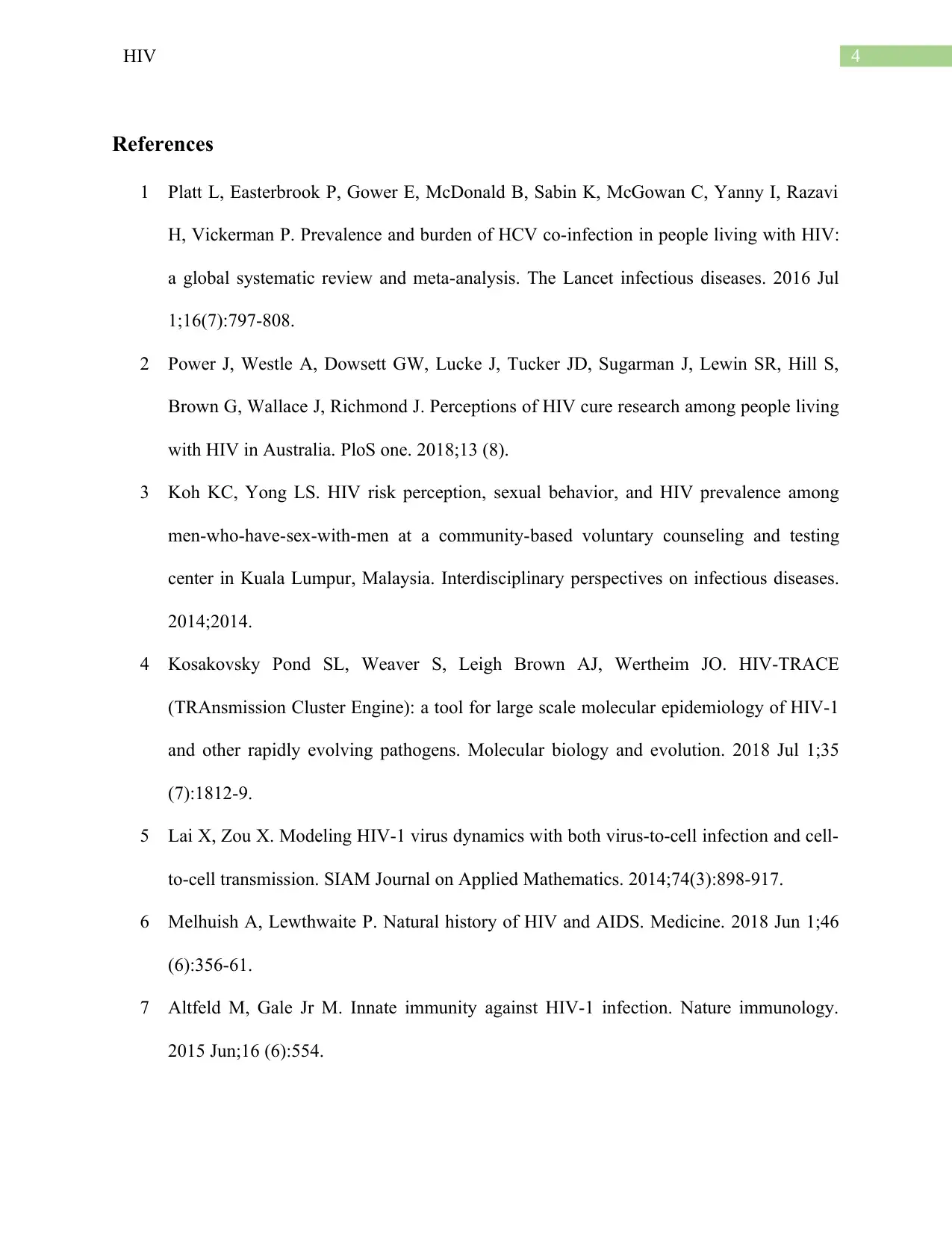
4HIV
References
1 Platt L, Easterbrook P, Gower E, McDonald B, Sabin K, McGowan C, Yanny I, Razavi
H, Vickerman P. Prevalence and burden of HCV co-infection in people living with HIV:
a global systematic review and meta-analysis. The Lancet infectious diseases. 2016 Jul
1;16(7):797-808.
2 Power J, Westle A, Dowsett GW, Lucke J, Tucker JD, Sugarman J, Lewin SR, Hill S,
Brown G, Wallace J, Richmond J. Perceptions of HIV cure research among people living
with HIV in Australia. PloS one. 2018;13 (8).
3 Koh KC, Yong LS. HIV risk perception, sexual behavior, and HIV prevalence among
men-who-have-sex-with-men at a community-based voluntary counseling and testing
center in Kuala Lumpur, Malaysia. Interdisciplinary perspectives on infectious diseases.
2014;2014.
4 Kosakovsky Pond SL, Weaver S, Leigh Brown AJ, Wertheim JO. HIV-TRACE
(TRAnsmission Cluster Engine): a tool for large scale molecular epidemiology of HIV-1
and other rapidly evolving pathogens. Molecular biology and evolution. 2018 Jul 1;35
(7):1812-9.
5 Lai X, Zou X. Modeling HIV-1 virus dynamics with both virus-to-cell infection and cell-
to-cell transmission. SIAM Journal on Applied Mathematics. 2014;74(3):898-917.
6 Melhuish A, Lewthwaite P. Natural history of HIV and AIDS. Medicine. 2018 Jun 1;46
(6):356-61.
7 Altfeld M, Gale Jr M. Innate immunity against HIV-1 infection. Nature immunology.
2015 Jun;16 (6):554.
References
1 Platt L, Easterbrook P, Gower E, McDonald B, Sabin K, McGowan C, Yanny I, Razavi
H, Vickerman P. Prevalence and burden of HCV co-infection in people living with HIV:
a global systematic review and meta-analysis. The Lancet infectious diseases. 2016 Jul
1;16(7):797-808.
2 Power J, Westle A, Dowsett GW, Lucke J, Tucker JD, Sugarman J, Lewin SR, Hill S,
Brown G, Wallace J, Richmond J. Perceptions of HIV cure research among people living
with HIV in Australia. PloS one. 2018;13 (8).
3 Koh KC, Yong LS. HIV risk perception, sexual behavior, and HIV prevalence among
men-who-have-sex-with-men at a community-based voluntary counseling and testing
center in Kuala Lumpur, Malaysia. Interdisciplinary perspectives on infectious diseases.
2014;2014.
4 Kosakovsky Pond SL, Weaver S, Leigh Brown AJ, Wertheim JO. HIV-TRACE
(TRAnsmission Cluster Engine): a tool for large scale molecular epidemiology of HIV-1
and other rapidly evolving pathogens. Molecular biology and evolution. 2018 Jul 1;35
(7):1812-9.
5 Lai X, Zou X. Modeling HIV-1 virus dynamics with both virus-to-cell infection and cell-
to-cell transmission. SIAM Journal on Applied Mathematics. 2014;74(3):898-917.
6 Melhuish A, Lewthwaite P. Natural history of HIV and AIDS. Medicine. 2018 Jun 1;46
(6):356-61.
7 Altfeld M, Gale Jr M. Innate immunity against HIV-1 infection. Nature immunology.
2015 Jun;16 (6):554.
1 out of 5
Related Documents
Your All-in-One AI-Powered Toolkit for Academic Success.
+13062052269
info@desklib.com
Available 24*7 on WhatsApp / Email
![[object Object]](/_next/static/media/star-bottom.7253800d.svg)
Unlock your academic potential
Copyright © 2020–2025 A2Z Services. All Rights Reserved. Developed and managed by ZUCOL.





